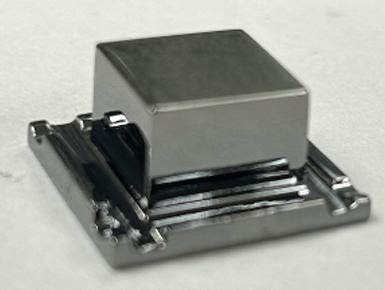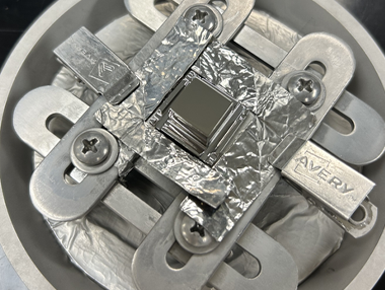USD Successfully Creates an HPGe Detector Using NSF-Supported AJA Sputtering System

Thanks to the National Science Foundation’s support for this advanced equipment, USD now has the infrastructure to develop large-scale detectors using the AJA system.
Unlike traditional setups, this system features a three-inch target size and a turbo pump rather than a cryogenic pump, enabling greater scalability while introducing unique technical challenges. Over the past two years, the research group of Dongming Mei, Ph.D., professor in the Department of Physics, worked diligently to overcome these challenges.
Graduate student Kunming Dong successfully produced the first detector—approximately 20 × 21 mm at the base, 13 × 14 mm at the top, and 10.4 mm thick—after key innovations to minimize water vapor and oxygen contamination. These efforts enabled precise amorphous germanium (a-Ge) coating, a crucial step for detector performance.
The model detector demonstrates excellent characteristics, including a full depletion voltage of 1400 V, an impurity concentration of 2.3 × 10¹⁰ cm⁻³, a leakage current of only 7 pA at 1600 V, and an energy resolution of 0.21% at 662 keV.
This achievement marks the first phase of USD’s Ring Contact Ge Detector Project, which aims to develop large-scale HPGe detectors using amorphous Ge as a p+ contact for leading experiments such as LEGEND, a flagship neutrinoless double-beta decay search. Continued process optimization will further enhance detector performance and reproducibility for large-scale applications.
Prior to acquiring the AJA sputtering system, the USD group had fabricated more than 40 small Ge detectors using an older sputtering machine that was limited to small-size fabrication. The recent success with the AJA machine demonstrates the feasibility of fabricating larger detectors suitable for strip detector designs. Such detectors promise not only excellent energy resolution but also high spatial resolution, positioning them as powerful tools for medical imaging applications aimed at early disease detection.
“This first success with the AJA sputtering machine is a critical step forward,” said Mei. “It shows that our team has the capability to extend detector fabrication from small prototypes to the larger formats required for advanced medical and scientific applications.”
With critical support from the NSF, USD has emerged as a national leader in large-size germanium detector creation. This investment in cutting-edge equipment marks a pivotal step forward in advancing USD’s research capabilities.





